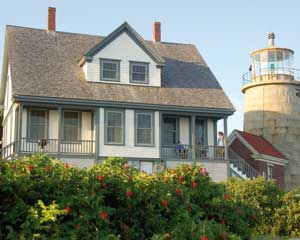July/August 2014 | view this story as a .pdf
Find your lost horizon by checking in at one of these lighthouse inns.
By Claire Z. Cramer
 Whitehead Light Station is one lucky lighthouse. Commissioned in 1803 as the seventh oldest lighthouse in the U.S. by President Thomas Jefferson, it received a 12-year makeover starting in 1997 when non-profit Pine Island Camp of Belgrade Lakes acquired it via the Maine Lights Program. Since 2009, the landmark has hosted retreats and entertains guests throughout the year.
Whitehead Light Station is one lucky lighthouse. Commissioned in 1803 as the seventh oldest lighthouse in the U.S. by President Thomas Jefferson, it received a 12-year makeover starting in 1997 when non-profit Pine Island Camp of Belgrade Lakes acquired it via the Maine Lights Program. Since 2009, the landmark has hosted retreats and entertains guests throughout the year.
Whitehead sits on 11 acres of 70-acre Whitehead Island off Spruce Head, three miles northeast of Tenants Harbor. “The innkeeper’s house was built in 1891 as a duplex because two families took turns keeping it,” says Gigi Lirot, the island’s manager as well as a licensed USCG captain, single-engine pilot, and avid scuba diver. Today, there are seven bedrooms, each with private bath. It’s $629 per couple for all-inclusive theme weekends such as cooking, wine and food, knitting. The entire cottage also rents by the week from $4,900.
Be prepared for splendid isolation. Whitehead Island averages “80 days of thick fog per year,” according Jeremy D’Entremont, historian for the American Lighthouse Foundation.
“There are no half-hearted guests at Goose Rocks. People either get it or they don’t,” says Dr. Casey Jordan, whose non-profit Beacon Preservation maintains Goose Rock, a lonely, lovely beacon in the Fox Islands Thoroughfare half a mile off North Haven Island. “We actually had guests on three nights last week.” Jordan purchased her lighthouse outright in 2006. She created the non-profit because she believed in “the whole ethos–a lighthouse should be about education and preservation.”
Goose Rocks is full immersion: there’s no island to roam. It’s just a lighthouse. You access the almost enchanted accommodations by climbing a vertical ladder. There’s solar power, “enough to charge your phone and run the composting toilet.” For the most part, children are not permitted.
“People call and say they want to rent the lighthouse. You don’t rent, you make a donation to Beacon. Every dime goes into preservation.
“You feel like the lighthouse keeper. This isn’t a B&B. There’s no room service. You’re going to experience terrible weather, you’re going to get wet. You’re going to bring your own food and grill it outside. You can’t call us at midnight for a beer run. I stayed out there five consecutive nights once by myself. It got a little Stephen King. I was socked in fog, and it wasn’t safe to take the boat out.”
What sorts of people seek out this experience? “Ninety percent of the guests are fantastic–they’ll say it was the high point of their trip to Maine, they send Christmas cards. We just had a couple in their 60s–it was on his bucket list.”
Jordan was the lightkeeper in 2010 and 2011. This summer, “I have a terrific engineering student, Tim Sweret, taking care of the lighthouse. It’s a tough job. You have to strip the linens, take them all to North Haven to launder and then return them, haul gallons and gallons of water.”
Up to six people can stay at Goose Rocks for a minimum of $600.
Casey Jordan also started the Green Light Academy in 2009, a two-week immersion program every summer for students to learn about lighthouses and visit a number of them. The academy is able to utilize the campus of the College of the Atlantic for its base.
In her other life, she’s a college professor. “I teach criminology at Western Connecticut University, and I’m a consultant for Investigation Discovery–the crime channel. I work on a show called Wives With Knives.”
“There are 300 to 400 people on the island in the summer, but only 38 in winter,” says Marshall Chapman, owner and innkeeper of Isle au Haut’s Keeper’s House.
Isle Au Haut’s lighthouse and outbuildings were built by the Army Corps of Engineers in 1907 land purchased from Charles Robinson. In 1934, the light was automated and the government sold everything except the actual light, which is just offshore, back to the Robinsons. In 1986, Jeffrey and Judi Burke bought the property and turned it into an inn they called the Keeper’s House.
The island stands seven miles off the tip of Stonington, a mythical beyond in Penobscot Bay, allegedly the last place in America to retire the crank telephone.
Marshall Chapman purchased the property in 2012. In winters, he’s a geology professor at the University of Kentucky. Summers, he presides over the operation and guests at the Keeper’s House–a four-room inn–and the tiny Oil House Bungalow, and two-bedroom Woodshed Cottage. ($350/$375; 2-night minimum; includes three meals a day).
“We have a modicum of solar electricity, and there is one outlet in every room. Each guest is given a candle lantern and a head lamp for reading in bed–we’re not completely 1907. We serve three gourmet meals a day. My cooks are excellent. We have a garden, and lobster and halibut right off the boat.”
What’s in the library? “Oh this and that. I’ve added biographies of Theodore Roosevelt, Winston Churchill, and some mysteries. There’s some progressive stuff left from the Burkes’ days, Abbie Hoffman’s Steal This Book, that kind of thing.
“Unless there’s foul weather, though, our guests aren’t the type to hang around reading. They’re out hiking or riding our bikes. In the evenings, after a five-course meal, they go to bed pretty quickly.
“There are five mail boats a day to Stonington; the first one leaves here at 8 a.m. and returns at 4:30. Sometimes guests go spend the day exploring the Blue Hill peninsula.
“Most guests spend two nights and say they wish they’d booked a third. It takes two to find your rhythm. You live by the tide here, and the mailboat schedule, and whether internet service is up.”






0 Comments